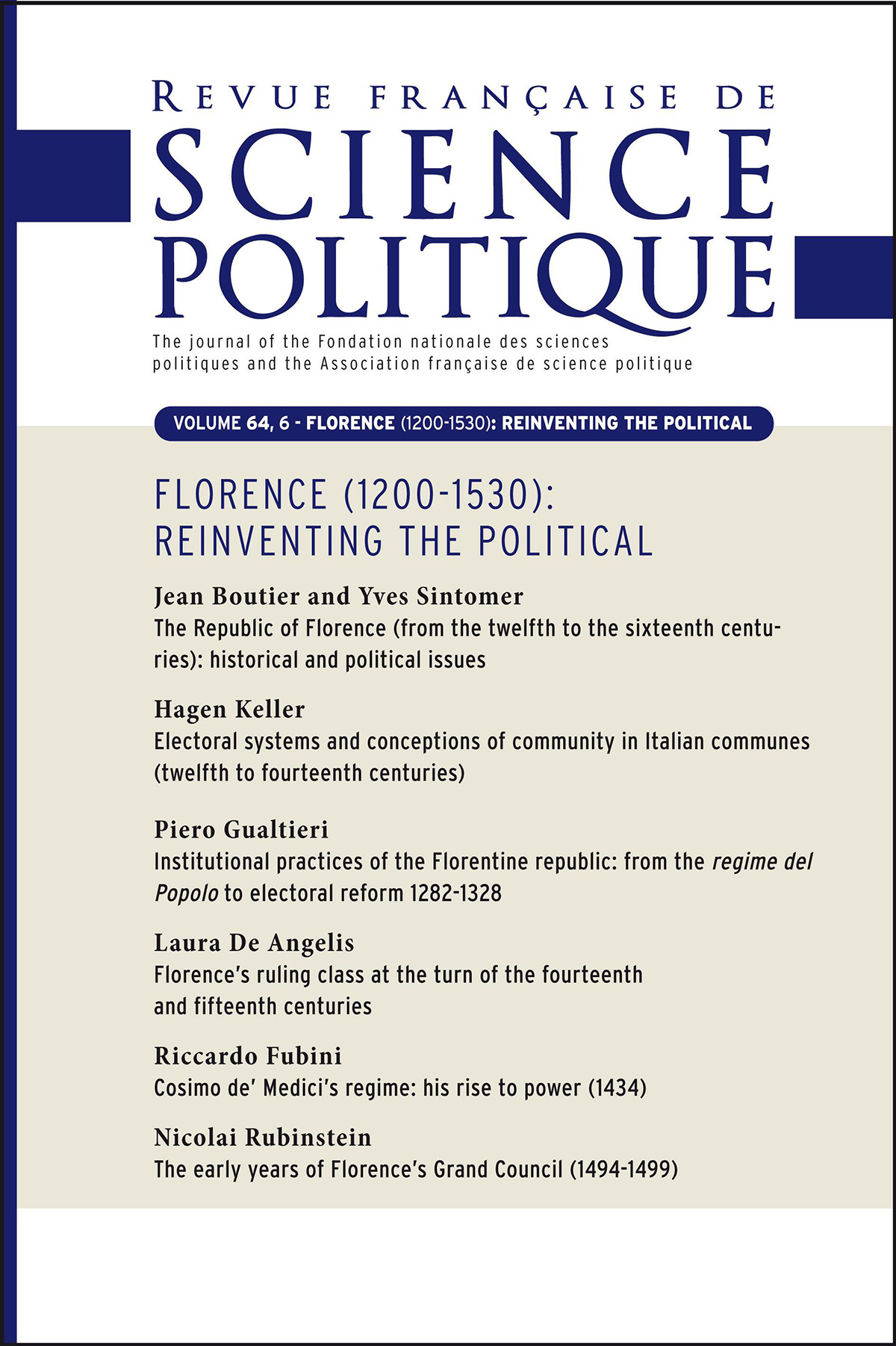Home>Finance>Why By The End Of The Fourteenth Century Did Florence Become An Important Banking City?


Finance
Why By The End Of The Fourteenth Century Did Florence Become An Important Banking City?
Published: November 2, 2023
Discover the key factors that transformed Florence into a prominent banking hub by the 14th century. Explore the role of finance in shaping the city's rise to financial power.
(Many of the links in this article redirect to a specific reviewed product. Your purchase of these products through affiliate links helps to generate commission for LiveWell, at no extra cost. Learn more)
Table of Contents
Introduction
In the late fourteenth century, the city of Florence underwent a remarkable transformation, evolving into one of the most powerful banking centers in Europe. This shift was fueled by a combination of economic, political, technological, and cultural factors that laid the foundations for Florence’s meteoric rise in the field of finance. This article will explore the key reasons why Florence became an important banking city by the end of the fourteenth century.
During this time, Florence experienced a period of economic growth and prosperity, which was largely driven by the city’s flourishing textile industry. The production and trade of high-quality woolen cloth known as “Florentine cloth” became the city’s main economic driver, attracting merchants from all over Europe. This economic prosperity created a favorable environment for the growth of banking activities in Florence.
Moreover, Florence was a center of political power and stability, which contributed to its standing as a prominent banking city. The city had a well-organized system of government, with various guilds and powerful families exerting influence. This political stability ensured a reliable legal framework for banking transactions and protected the interests of lenders and borrowers.
Additionally, the expansion of trade played a crucial role in Florence’s emergence as a banking hub. As trade routes expanded and international commerce grew, there was a growing demand for financial services such as currency exchange, letters of credit, and secure storage facilities for valuables. Florence’s strategic location in central Italy made it an ideal intermediary between northern and southern Europe, further cementing its position as a financial center.
One of the key catalysts for Florence’s rise in banking was the emergence of the Medici family. The Medici were influential bankers and financiers who leveraged their wealth and connections to establish a powerful banking dynasty. They played a pivotal role in financing the papacy, royal houses, and powerful merchants, solidifying Florence’s reputation as a reliable and influential hub for financial transactions.
Economic Factors
The economic factors that contributed to Florence becoming an important banking city during the late fourteenth century cannot be understated. At the heart of Florence’s economic prowess was its thriving textile industry, which propelled the city’s rapid growth and wealth accumulation. Florence was renowned for its production of high-quality woolen cloth, known as “Florentine cloth,” which captured the attention of European merchants.
The production of Florentine cloth was a highly specialized and lucrative trade that brought substantial wealth to the city. Florence had abundant access to raw materials such as wool and silk, and its skilled artisans employed innovative techniques, resulting in the creation of luxurious and sought-after textiles. The demand for Florentine cloth spread across Europe, and Florence became a hub for textile production, attracting wealthy merchants and traders from all corners of the continent.
This flourishing textile industry created a vibrant economy in Florence, with a strong emphasis on commerce and trade. The abundance of wealth generated from textile production fueled the growth of banking activities. Merchants required secure and efficient financial services to facilitate their transactions, such as loans, credit, and currency exchange. This demand for financial services created a fertile ground for banking institutions to thrive.
Add to this the fact that Florence had a stable and reliable currency, further bolstering its position as a financial powerhouse. The city’s coinage, the florin, was widely recognized and accepted throughout Europe. Its consistent weight and purity made it a trusted medium of exchange, attracting merchants and traders who sought a stable monetary system for their business dealings.
Furthermore, Florence’s strong business culture and entrepreneurial spirit played a significant role in its ascent as a banking city. The city fostered an environment that encouraged innovation, risk-taking, and entrepreneurial ventures. This culture of business excellence attracted talented individuals with a keen interest in finance and banking, further fueling the growth of the banking industry in Florence.
In summary, the economic factors that led to Florence becoming an important banking city were its thriving textile industry, a stable and trusted currency, and a vibrant business culture. The wealth generated from the textile trade created a demand for financial services, and Florence was well-positioned to meet this demand. These economic conditions, combined with a favorable business environment, laid the foundations for Florence’s rise as a prominent banking center in the late fourteenth century.
Political Factors
The political landscape of Florence played a crucial role in transforming the city into an important banking center by the end of the fourteenth century. Florence was known for its stable and well-organized system of government, which provided a conducive environment for banking activities to thrive.
One key political factor was the existence of powerful guilds in Florence. These guilds represented various professional and trade associations, including bankers and moneylenders. The guilds had considerable influence and played a vital role in shaping economic policies and regulations. They ensured fair and transparent business practices, which instilled trust among merchants and lenders, making Florence an attractive destination for financial transactions.
Another significant political factor was the presence of powerful families who held sway over the city. These families, such as the Medici, had amassed immense wealth and influence, using it to establish themselves as prominent bankers and financiers. Their connections in political circles, both locally and internationally, played a pivotal role in expanding Florence’s reach and reputation as a banking hub.
The stability of Florence’s political system was also instrumental in the city’s rise as a banking center. Unlike many other Italian city-states of the time, Florence experienced relative political stability, with a well-established legal system that protected the rights and interests of lenders and borrowers. This stability provided a secure and reliable environment for conducting financial transactions, attracting both domestic and international merchants.
The political stability in Florence was further enhanced by the strong rule of law. The city had well-defined commercial laws and a robust judicial system that provided a framework for resolving disputes and enforcing contracts. This legal certainty was vital for merchants and bankers, who relied on the ability to enforce agreements and seek recourse in case of disputes.
Additionally, Florence’s political connections with the papacy and other powerful entities further bolstered its position as a banking center. The city’s close ties with the Vatican allowed for lucrative financial arrangements, such as providing loans and managing the wealth of the Church. These connections brought significant financial opportunities and cemented Florence’s reputation as a trusted financial partner.
In summary, the political factors that contributed to Florence’s transformation into an important banking city included the influential guilds, the power held by prominent families, the stability of the political system, the rule of law, and the city’s political connections. These factors provided a solid foundation for the growth of the banking industry in Florence and attracted merchants and investors interested in conducting secure and profitable financial transactions.
Expansion of Trade
The expansion of trade played a pivotal role in the rise of Florence as an important banking city by the end of the fourteenth century. As Europe experienced a period of economic growth, trade networks began to expand, and Florence positioned itself as a key intermediary in this flourishing commerce.
Florence’s strategic location in central Italy made it an ideal hub for trade between northern and southern Europe. The city was situated near major trade routes, connecting it to important commercial centers such as Venice, Genoa, and Rome. This geographical advantage allowed Florence to become a crucial trading post, attracting merchants and traders from diverse regions.
Furthermore, Florence’s merchants became renowned for their business acumen and entrepreneurial spirit, fostering a reputation for reliability and trustworthiness in commercial dealings. The city’s merchants engaged in long-distance trade, importing goods from the East, such as spices, silk, and luxury items. They then exported these goods to other European cities, generating substantial wealth and fueling the demand for financial services.
The expanding trade networks necessitated financial instruments to facilitate transactions and mitigate risks. Florence became a pioneer in developing innovative financial tools to support trade. One such instrument was the letter of credit, which allowed merchants to conduct business with minimal risk. The Medici family, in particular, played a significant role in popularizing and refining the use of the letter of credit, further solidifying Florence’s position as a center for trade and finance.
Moreover, Florence’s expanding trade relations with the growing cities of Flanders and England played a pivotal role in its economic success. These regions were major textile producers, and Florence became a significant market for their products. The increased trade with Flanders and England not only boosted Florence’s textile industry but also fostered the growth of banking activities as financial services were essential for handling the transactions between these regions.
The expansion of trade also led to the emergence of marketplaces and fairs in Florence, which attracted merchants from all over Europe. These marketplaces served as meeting points for buyers and sellers, facilitating trade and commerce. Financial institutions, such as banks and money changers, naturally sprang up around these marketplaces to cater to the financial needs of the merchants, further enhancing Florence’s reputation as a banking city.
In summary, the expansion of trade and Florence’s strategic location positioned the city as a vital commercial hub. The city’s reputation for trustworthy merchants, coupled with the development of innovative financial instruments, attracted traders from all over Europe. This increased trade and the subsequent demand for financial services propelled Florence’s growth as a leading banking city by the end of the fourteenth century.
Emergence of the Medici Family
The emergence of the Medici family was a pivotal factor in Florence’s transformation into an important banking city by the end of the fourteenth century. The Medici, a prominent banking dynasty, rose to power and influence, reshaping the financial landscape of the city.
The Medici family began as successful merchants, trading in a variety of goods including textiles, spices, and luxury items. Through their astute business practices, they accumulated substantial wealth and established strong connections with prominent families and institutions across Europe.
With their wealth and connections, the Medici family turned their attention to banking and finance. They recognized the growing need for financial services and positioned themselves as trusted lenders and advisors. Their network of relationships allowed them to extend loans to powerful entities such as the Vatican, royal houses, and influential merchants.
The Medici family’s expertise in banking and finance led to the refinement and development of financial instruments that facilitated trade and investment. They played a significant role in popularizing the use of bills of exchange, promissory notes, and letters of credit. These financial innovations provided merchants with greater flexibility and security in their commercial activities, attracting more trade and further enriching Florence’s financial landscape.
What set the Medici family apart was not only their financial expertise, but also their ability to leverage their wealth for political influence. They strategically aligned themselves with the ruling class of Florence, forming alliances and even producing several prominent political figures, including two popes. This political clout allowed the Medici family to shape economic policies and regulations that were favorable to their banking activities.
The Medici family’s impact extended beyond Florence. They established branches of their banking operations in key European cities such as Venice, Rome, and London, solidifying their presence in international finance. These branches facilitated trade and money transfers, expanding the reach of Florentine banking and cementing the Medici family’s reputation as influential financiers.
Furthermore, the Medici family’s patronage of the arts and support for intellectual pursuits contributed to the cultural and intellectual vibrancy of Florence. They funded artists, architects, and scholars, attracting creative and intellectual minds to the city. This cultural effervescence added to the city’s allure and prestige, attracting further attention from merchants and investors.
In summary, the emergence of the Medici family as prominent bankers and financiers played a significant role in Florence’s ascension as an important banking city. Their wealth, financial innovation, political influence, and patronage of the arts contributed to the growth and reputation of Florentine banking. The Medici family became synonymous with the banking industry in Florence and solidified the city’s position as a leading financial center in Europe.
Technological Advancements
Technological advancements played a vital role in Florence’s journey to becoming an important banking city by the end of the fourteenth century. These advancements allowed for greater efficiency, security, and convenience in financial transactions, facilitating the growth of banking activities in the city.
One significant technological advancement was the invention of the double-entry bookkeeping system. Developed by Luca Pacioli, an Italian mathematician and Franciscan friar, this system revolutionized accounting practices. Double-entry bookkeeping enabled bankers to keep accurate and detailed records of financial transactions, enhancing transparency and accountability in banking operations. This system provided a solid foundation for Florence’s burgeoning banking industry, as it allowed for better management of accounts and more informed decision-making.
The advent of the printing press also had a profound impact on the banking sector. Johannes Gutenberg’s invention in the mid-fifteenth century allowed for the mass production of books, including accounting ledgers and financial records. This significantly improved the efficiency of record-keeping, making it easier for bankers to manage and analyze financial data. The printing press also facilitated the dissemination of financial information, enabling a wider audience to access banking and financial knowledge.
Another technological advancement that transformed the banking industry was the development of secure and innovative methods for storing valuables. In Florence, banks began utilizing advanced vaults and lock systems, providing merchants and wealthy individuals with a safe place to store their assets. These secure storage facilities helped attract wealthy individuals, who valued the safety and security of their valuables, further contributing to the growth of Florence’s banking reputation.
Additionally, advancements in transportation played a crucial role in the development of Florence as a banking city. Improved transportation systems, such as the use of horses and carriages, allowed for faster and more efficient movement of goods and people. This facilitated trade and commerce, making Florence a more accessible and attractive destination for merchants and traders. The ability to move goods and funds quickly and reliably was essential for the growth of banking activities in the city.
The adoption and usage of new technologies were not limited to banking operations themselves. Florence also embraced technological advancements in other industries, which had a ripple effect on the banking sector. The flourishing textile industry, for instance, utilized innovative machinery like the spinning wheel and mechanical looms. These advancements in textile production increased productivity and profitability for textile merchants, creating demand for financial services and further fueling the growth of Florence’s banking sector.
In summary, technological advancements, such as double-entry bookkeeping, the printing press, secure storage systems, and improved transportation, played a pivotal role in Florence’s development as an important banking city. These advancements increased efficiency, enhanced security, and facilitated the growth of banking operations, attracting merchants and investors to the city. Florence’s embrace of technological progress propelled its ascent as a significant player in the European banking landscape.
Financial Innovations
The development of financial innovations was a key factor in Florence’s rise as an important banking city by the end of the fourteenth century. These innovations transformed the way financial transactions were conducted, providing increased flexibility, efficiency, and security for merchants and lenders.
One of the significant financial innovations was the creation and widespread use of bills of exchange. A bill of exchange was a written order that allowed commerce to be conducted across vast distances. Merchants could purchase goods from one region and defer payment until a later date, allowing for smoother and more efficient trade. The bills of exchange provided a mechanism for transferring funds without the need for physical transportation of coins, reducing risk and facilitating international trade.
Another groundbreaking financial innovation was the development and refinement of promissory notes. These notes were written promises to pay a certain sum of money by a specified date. Promissory notes enabled merchants to extend credit to each other, providing a means for financing their trade activities. This financial instrument served as evidence of a debt and helped facilitate trust and confidence in financial transactions, contributing to the growth of Florence’s banking industry.
In addition to bills of exchange and promissory notes, the concept of fractional reserve banking emerged during this period. Fractional reserve banking allowed banks to hold only a fraction of their deposits in reserve, while lending out the rest at interest. This practice created the potential for banks to expand their lending activities and increase the supply of credit in the economy. This financial innovation promoted economic growth and provided merchants with access to much-needed capital for their businesses.
Florence also witnessed the growth of insurance contracts, particularly maritime insurance. Traders faced numerous risks when transporting goods across long distances, including the perils of sea voyages. Insurance contracts provided protection against the loss or damage of goods during transit, reducing the risk and uncertainty associated with trade. The availability of insurance coverage enabled merchants to undertake more ambitious and profitable trading ventures, contributing to the growth of Florence’s banking sector.
Additionally, the concept of joint-stock companies began to take shape during this period. These companies allowed investors to pool their resources and share the risks and profits of a business venture. Joint-stock companies provided a mechanism for raising substantial amounts of capital for large-scale projects, such as overseas exploration and trade expeditions. The formation of these companies facilitated entrepreneurial activities, expanded economic opportunities, and furthered the growth of Florence’s banking sector.
In summary, financial innovations such as bills of exchange, promissory notes, fractional reserve banking, insurance contracts, and joint-stock companies revolutionized the way financial transactions were conducted in Florence. These innovations provided merchants with increased flexibility, access to credit, and risk mitigation, fostering a thriving business and banking environment. The development and adoption of these financial instruments and concepts propelled Florence’s ascent as an important banking city in the late fourteenth century.
Cultural Developments
Cultural developments played a significant role in Florence’s transformation into an important banking city by the end of the fourteenth century. The cultural vibrancy and intellectual climate of the city attracted talented individuals, fostered innovation, and contributed to the growth of the financial sector.
Florence was a hub of artistic and intellectual activity during this period, known as the Renaissance. The city was home to renowned artists, architects, writers, philosophers, and scientists who pushed the boundaries of creativity and knowledge. The flourishing cultural scene in Florence helped create a favorable environment for the growth of banking and finance.
Under the patronage of wealthy merchants and influential families like the Medici, Florence became a center for artistic and intellectual pursuits. The Medici family, in particular, played a crucial role, supporting artists such as Michelangelo, Leonardo da Vinci, and Botticelli. This patronage attracted creative and intellectual minds to the city, who in turn contributed to the city’s prosperity by infusing it with new ideas and perspectives.
The cultural developments in Florence also enhanced the city’s reputation and prestige, attracting merchants and investors from various regions. The prosperous and vibrant artistic climate created an aura of sophistication, making Florence an attractive destination for individuals seeking both cultural enrichment and financial opportunities.
The influence of the Renaissance extended beyond the arts. It brought about a shift in thinking and a renewed emphasis on humanism and the pursuit of knowledge. This intellectual mindset supported the growth of banking and finance, as it encouraged critical thinking, innovation, and a strong business acumen among the merchants and bankers of Florence.
Furthermore, the Renaissance witnessed a revival of interest in classical learning, particularly in disciplines like mathematics, economics, and philosophy. This intellectual curiosity and pursuit of knowledge fostered a climate conducive to financial innovation. It influenced the development of financial theories and practices, promoting a more sophisticated understanding of banking and finance in Florence.
The cultural developments in Florence also had a practical impact on the banking industry. With the growth of trade and commerce, there was a need for a system of weights, measures, and standardization. In response, the Florentine government implemented a system known as the “bianco per tara,” which regulated the weights and measures used in commercial transactions. This standardization provided merchants and bankers with a reliable framework for conducting business, enhancing trust and efficiency in financial transactions.
In summary, the cultural developments in Florence, particularly during the Renaissance period, played a vital role in the city’s emergence as an important banking center. The artistic and intellectual richness of the city attracted talent, fostered innovation, and contributed to the growth of the financial sector. The cultural climate, patronage of the arts, emphasis on humanism, and pursuit of knowledge all created a conducive environment for the thriving banking industry in Florence.
Conclusion
The transformation of Florence into an important banking city by the end of the fourteenth century was the result of a combination of economic, political, technological, and cultural factors. The city’s thriving textile industry, stable political system, strategic location, and expansion of trade all provided the necessary conditions for the growth of banking activities. Additionally, the emergence of the influential Medici family, technological advancements in accounting and transportation, and the development of financial innovations further propelled Florence’s ascent as a prominent banking center.
The economic prosperity generated by Florence’s textile industry attracted merchants from across Europe, fostering a demand for financial services. The stability of the city’s political system and its influential guilds provided a reliable legal framework for banking transactions, ensuring trust and confidence. Florence’s strategic location and expanding trade routes made it an ideal hub for commerce, attracting merchants and traders from diverse regions.
The rise of the Medici family as prominent bankers and financiers played a significant role, as their wealth, connections, and political influence helped shape the financial landscape of Florence. Technological advancements, such as double-entry bookkeeping and secure storage systems, enhanced the efficiency and security of financial transactions. Financial innovations, including bills of exchange, promissory notes, and fractional reserve banking, revolutionized the way banking operations were conducted.
Florence’s cultural developments, particularly during the Renaissance period, added to the city’s allure and prestige. The patronage of the arts, intellectual curiosity, and pursuit of knowledge created a vibrant and innovative environment that fostered the growth of banking and finance. The cultural vibrancy of Florence attracted talented individuals and contributed to the city’s reputation as a center of artistic and intellectual excellence.
In conclusion, the convergence of economic, political, technological, and cultural factors propelled Florence’s transformation into an important banking city. The thriving textile industry, stable political system, strategic location, financial innovations, and cultural developments all played their part in shaping the city’s rise as a prominent financial hub. Florence’s legacy as a significant banking center from the late fourteenth century continues to be celebrated and remembered today.














